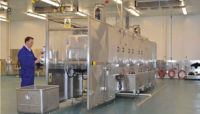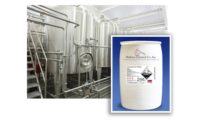It’s a Wash!
By Lynn Petrak,
Special Projects Editor
Sanitizers do the dirty work on equipment, surfaces, and personnel.
If cleanliness is next to godliness, then those who work in meat- and poultry-processing facilities have to be feeling pretty lofty these days. Sanitizers of one sort or another can be found throughout most plants, with systems ranging from the simple yet effective to the integrated and comprehensive.
To be sure, there’s a whole lot of scrubbing going on, especially when one compares the current preventative measures to those taken even a decade ago. From personal hygiene to food contact surface cleaning, sanitizers are nearly ubiquitous.
“It’s from the entrance to the exit — from the raw product entering the door to the finished food going out the door,” observes Paul Barnhill, president and chief executive officer of Meritech Inc., Centennial, CO, which supplies a full line of employee hygiene systems.
Such blanket coverage, so to speak, has stemmed from a variety of factors, most notably the ongoing emphasis on food safety.
“What drives it are multiple interventions. Processors are looking at how many different places they can intervene to help ensure food safety,” explains Roger Tippett, senior research and development program leader for food, meat, and poultry for St. Paul, MN-based Ecolab Inc., an international cleaning and sanitizing supplier.
The need to prevent cross contamination and to attack pathogens wherever they might grow makes the sanitation needs of meatpacking plants unique in a variety of ways. “Meat and poultry plants differ from other food plants in that there are varying needs for sanitation — where some applications need only a water hose to reduce the spread of germs, there are other applications within the same plant that require very hot water, or in some cases, steam to sanitize the area,” points out Jacquie Wells, marketing coordinator for ALTO Cleaning Systems Inc., a Pineville, NC subsidiary of the international powered cleaning equipment supplier Nilfisk-ALTO.
Regulations on a federal, state, and local level also have caused processors to make sure their operations and product handlers are as clean as possible. “As federal standards change, so do the needs for processors. Cleaning standards have consistently become more stringent with each passing year, therefore, it has become more necessary for processors to update their sanitation programs,” Wells notes.
Despite the work and expense involved in creating tighter standards for sanitation, processors can take heart that such measures ultimately are effective. “We believe that the new procedures are an ongoing process and have played a key role in the recent drop in foodborne illnesses,” relays Tim Condrey, area sales manager for sanitation system supplier Systemate Numafa USA, Canton, GA, adding that the impetus often has come from processors and suppliers alike. “We have seen a number of changes in the processing within the manufacturing facilities that have us continuously going back and taking another look at how we approach our designs and methods of cleaning towards eliminating the chance for cross-contamination.”
New and improved
As Condrey points out, suppliers of sanitizers continually work to provide new products and delivery systems that work to reduce the risk of cross-contamination. Although the desire clean up grease, blood, and the like is not new, many applications are different today.
Equipment sanitation has been one major area of emphasis. Systemate Numafa, for example, recently made some refinements to its equipment used in meat-processing operations, which includes a series of vat/container washers. “As capacities continue to increase, improvements to the automatic loading and discharge of the individual washers themselves, including the de-stacking and re-stacking, for both large vats and small totes or baskets have been made,” reports Condrey. “Other improvements have been made in the areas of the water filtration of their recirculating water systems, as well as the energy savings that can be achieved as they relate to their drying.”
As systems become more automated, Condrey adds, reliability and accountability are top priorities. “We think the ability to be able to self monitor these systems’ operations is crucial. The information generated is valuable as it relates to ensuring product wholesomeness throughout the entire manufacturing process and in providing information critical to the systems’ ongoing production and maintenance schedules,” he says.
ALTO Cleaning Systems also has tweaked some of its industrial washers found in meat and poultry plants, recently rolling out a series of non-stationary pressure washers designed for increased flexibility. “These are mobile machines that can be used in any food processing plant. The Poseidon series machines are cold-water machines and the Neptune series machines are hot water machines,” explains Wells, adding that there are different models within each category with different capacities.
Wells adds that improvements in washers have been developed based on several factors. “The most recent innovation developed by ALTO is a more fuel-efficient burner system, which was introduced with the launch of the new Neptune series machines,” she relates, adding that the burner system operates at 92 percent efficiency level to help lower fuel costs.
In addition to industrial washers, plant operators are also looking for sanitizers that can be applied to clean a facility’s proverbial nooks and crannies, from conveyor belts to drains. For example, beyond various antimicrobial products used for equipment and food products, Ecolab offers Vortexx , an EPA-registered peracid sanitizer that can be applied in a variety of spots in meat plants. “What is different about that is that it is used on a continuous basis,” explains Tippett. “In traditional cleaning and sanitizing, after production is finished you put something in a pump and sanitize it, but with Vortexx it can be used continuously for treatments of conveyors during production to reduce the incidence of undesirable microorganisms.”
Ecolab developed another sanitizing product, called Whisper, two years ago. “That is a quaternary ammonium sanitizer applied after cleaning. It registers as a no-rinse sanitizer on food contact surfaces, and its key attribute is that it is low-foaming and has an increased tolerance to hard water conditions and soiling,” says Tippett, adding that processors can apply that product at a higher concentration in critical areas, if needed.
Although sanitizers used on equipment and contact surfaces typically include some type of cleanser, there are other options as well. AmeriVap Systems, Atlanta, GA, for example, offers dry steam-based technology to rid areas of contaminants. In addition to reducing a plant’s inventory of cleaning materials and the requisite tools and equipment, the system has been shown to be effective in cleaning hard-to-reach surfaces in food processing facilities. “It basically allows people to clean the most difficult of areas, including the electrical panels, control panels, touchscreen gears, change drives, sprockets and things like that,” remarks company president Werner Diercks, adding that the system has been shown to work on microorganisms of concern. “Meat and poultry companies can control Listeria, for example - just fill a drain with dry steam and Listeria is history.” AmeriVap’s dry steam vapor systems are portable, he adds, which gives operators greater versatility and convenience.
Getting personal
In the ongoing battle to reduce the potential of cross contamination, personal (or personnel to be more exact) hygiene is another major front. As anyone on the plant floor can attest, there is a rigorous sanitation routine one must follow, from suiting up in protective clothing to using sanitizers throughout the day and throughout the line.
Meritech specializes in employee hygiene. Among its latest systems is the CleanTech® 500EZ hand washer, introduced in the past year. “You get high quality hand washing and this one is small, compact and priced in the mid $2,000s. It’s inexpensive and is becoming very popular,” says Barnhill. Among other features, the CleanTech 500EZ includes a solution monitor, stainless steel components and a cylinder rotation limit.
The company has also worked to improve its ProTech series of high-throughput washing systems, used on a walk-through basis for hand and boot washing. “You can sanitize boots without any stopping or down time,” notes Barnhill. That system is available to wash hands and boots at the same time, or hands only.
Barnhill, relays that some of the sanitizer demands coming from Meritech’s meat and poultry customers have stemmed from the challenges that arise from plant renovation and construction projects. “In a lot of plant operations, you have one facility that has been built and established, and as the business grows they basically add another box on the building. So you end up with numerous entrances and exits and go into areas that require further sanitation,” he points out.
Meanwhile, as part of its arsenal of sanitizers, Ecolab has a personnel hygiene program under its EcoCare umbrella. John Richards, vice president of marketing and development, meat and poultry products, says the system includes an integrated line of hand cleaners and sanitizers, doorway sanitizing systems, EPA-registered environmental sanitizers, programmable doorway foamers, and no-touch dispensers. “We try to be smart about how we apply the chemistry. We have programs so the systems will turn on at the right minute,” Richards explains, adding that across-the-board coverage is essential in the critical control point of employee practices. “One of our customers has a light go off every fifteen minutes, so employees have to stop what they are doing and get their hands resanitized.”
Likewise, the development team at Systemate Numafa has seen inquires about employee hygiene systems steadily increase as well. “We have also improved and reintroduced our personal hygiene equipment line, including boot washing and hand sanitizing,” reports Condrey.
Whether used on people, places, or things, sanitizers are moving ahead with technology, often led by factors and demands within the industry. “I think every customer is developing better quality standards. Obviously they are doing that for their products, but they are also doing it for when they get inspected,” says Barnhill, adding that the next generation of sanitizers is likely to be developed on a collaborative basis. “The advances are coming directly from our customers who want better throughput, better quality, less time and things that are more user friendly.”
Richards, too, says that demand will only increase for sanitizers that are effective as they are cost effective in the long run. “A growing number of plants are recognizing that there is a complete strategy for food safety. We are actively doing more research in the areas of sanitizers, looking at enhancing existing interventions and introducing new technologies.” NP
Technology providers participating in this report include:
ALTO Cleaning Systems Inc., phone (704) 971-1240 or (877) 366-2586, e-mail info@altocsi.com, or visit www.alto-online.com
AmeriVap Systems, phone (404) 350-0239 or (800) 763-7687, e-mail werner.diercks@amerivap.com, or visit www.amerivap.com
Ecolab Inc., phone (651) 293-2233 or (800) 392-3392, or visit www.ecolab.com
Meritech Inc., phone (303) 790-4670 or (800) 932-7707, e-mail cleantech@meritech.com, or visit www.meritech.com
Systemate Numafa USA, phone (770) 345-1055, e-mail scott@numafa.com, or visit www.rumafa.com


Report Abusive Comment